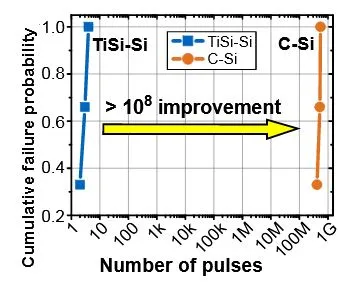A new paper has been published in the open-access IEEE Journal of the Electron Devices Society. "Graphenic Carbon: A Novel Material to Improve the Reliability of Metal-Silicon Contacts"
Abstract: Contact resistance and thermal degradation of metal-silicon contacts are major challenges in nanoscale CMOS as well as in power device applications. Titanium silicide (TiSi) is commonly used to establish low-barrier height contacts to silicon, in state-of-the-art FinFETs or Schottky diodes. But the metal is known to diffuse into the active region under high current stress, as during an electro-static discharge (ESD) event. This work shows with a Schottky diode as test vehicle that a carbon-silicon (C-Si) contact has the same low Schottky barrier height as a TiSi-Si junction but is over 100 million times more stable against high current pulses. A Schottky barrier height between 0.36 eV and 0.45 eV can be obtained by a variation of the deposition process. This makes C-Si a promising candidate for future high current density and temperature stable contacts and even for applications that require low contact resistances.
The work is supported by Deutsche Forschungsgemeinschaft (DFG) through the TUM International Graduate School of Science and Engineering (IGSSE) and the Open Access Publishing funding program of the Technical University of Munich (TUM).
The paper can be downloaded for free here.
UPDATE: It seems that Intel's 3D XPoint memory is using carbon interconnect material as its
OTS and PCM contacts. The TEM-images indicate a low density (~2 g/cm3) interconnect material like carbon.
